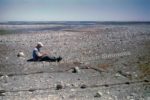- Bird Rock Puffins, 1937
- Wings Against the Wind, 1935
- Net Mending, 1958
- Easy Catch, 1937
- Westport Tuna Derby, 1940
- Great Blue Heron, 1935
Albert Dixon Simmons, naturalist, outdoors photographer, author, and guide
Archive Representative: John W. Flynn, Jr. adsimphoto@gmail.com
Albert Dixon Simmons (1892-1972) was a pioneer in nature action photography and filmmaking, their use in studying the flight mechanics of birds, and the use of Kodachrome color films. He authored two photography books in association with noted sporting genre publisher and editor Eugene V. Connett III.
A native of Prince Edward Island and 1916 M.I.T. graduate (Architecture), the Great Depression forced a career reset and focus shifted to his passion for the outdoors, at first using cameras to reveal the technical nuances of avian flight. Adapting a camera mount to a rifle stock with open gun sights, Simmons “shot” fast-moving birds in flight, with revealing slow motion footage, and elegant images from 35mm negatives collectively published as Wing Shots (1936, Derrydale Press, NY). With its release noted by Time magazine, each of the 83 images was a gravure print made from a corresponding mounted, titled and signed black & white photograph, but no text beyond the contents and Forward pages. Selected images were included in Leica’s promotional touring exhibits, the 1937 Leica Annual, and Leica Manual, print ads, and articles he published in Nature and Field & Stream magazines. In 1936, he also became involved with the first generation of Kodachrome transparency and motion picture films, traveling to the US Gulf Coast and, in 1937, to Bird Rock (Rochers aux Oiseaux) in Canada, to document migratory species with some of the first color transparencies and films of birds in the wild.
Wing Shots images comprise nearly all of Simmons’s signed printed works; he made only a few personal prints from Bird Rock images and a handful of prints after the 1930s, preferring transparencies for slide show presentations. He continued to write and photograph commercially for wartime and sporting publications and equipment manufacturers, was Outdoors editor for the Cleveland News, provided radio commentary, and maintained relationships with the Cleveland Zoo and Cleveland Museum of Natural History throughout his life. He contracted as guide/photographer for hunting and fishing expeditions, with the experiences from Alaska to Africa culminating in Photography for Sportsmen (1951, D. van Nostrand, NY), a detailed how-to guide for nature and outdoors photographers and filmmakers.
Each year, Simmons and his wife summered in her native Nova Scotia, combining family, friends, and work, until his death there in 1972. His cameras and extensive library, many negatives, transparencies, prints, and motion pictures, were sold, given away, or misplaced in the ensuing years, but the majority of original Wing Shots negatives and many early Kodachromes, as well as unpublished images depicting Maritime province life in the 1950’s and early ‘60s, were kept by his daughter but remained idle for decades.
The chance discovery in 2011 of a manuscript about Bird Rock, hand-assembled by Simmons and begun over 70 years earlier, confirmed a family rumor that, in his last years, he was attempting to complete a third book, though nothing was found after his passing. Early in 1972, in failing health, Simmons had sent the manuscript to the colleague who accompanied him to Bird Rock thirty-five years earlier, in 1937, as a gesture of friendship and thanks. Amazingly, through charmed kismet and the internet, it joined the rest of the Simmons archive, which is managed by his grandson.
The George Eastman House keeps a small number of Simmons’s transparencies in its permanent collection as examples of first-generation Kodachrome and glass slide mounting technique.






